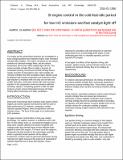SI Engine Control in the Cold-Fast-Idle Period for Low HC Emissions and Fast Catalyst Light Off
Author(s)
Cedrone, Kevin; Cheng, Wai K.
Download5_2014-01-1366 fast idle control.pdf (1.610Mb)
OPEN_ACCESS_POLICY
Open Access Policy
Creative Commons Attribution-Noncommercial-Share Alike
Terms of use
Metadata
Show full item recordAbstract
The engine and its exhaust flow behaviors are investigated in a turbo-charged gasoline direct injection engine under simulated cold-fast-idle condition. The metrics of interest are the exhaust sensible and chemical enthalpy flows, and the exhaust temperature, all of which affect catalyst light off time. The exhaust sensible enthalpy flow is mainly a function of combustion phasing; the exhaust chemical enthalpy flow is mainly a function of equivalence ratio. High sensible and chemical enthalpy flow with acceptable engine stability could be obtained with retarded combustion and enrichment. When split injection is employed with one early and one later and smaller fuel pulse, combustion retards with early secondary injection in the compression stroke but advances with late secondary injection. Comparing gasoline to E85, the latter produces a lower exhaust temperature because of charge cooling effect and because of a faster combustion.
Date issued
2014-04Department
Massachusetts Institute of Technology. Department of Mechanical Engineering; Sloan Automotive LaboratoryJournal
SAE International Journal of Engines
Publisher
SAE International
Citation
Cedrone, Kevin, and Wai K. Cheng. “SI Engine Control in the Cold-Fast-Idle Period for Low HC Emissions and Fast Catalyst Light Off.” SAE Int. J. Engines 7, no. 2 (April 1, 2014): 968–976.
Version: Author's final manuscript
ISSN
1946-3944
1946-3936